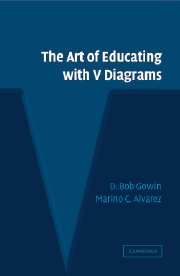Book contents
- Frontmatter
- Contents
- Foreword
- Preface
- Acknowledgment
- PART ONE FOUR COMMONPLACES OF EDUCATING PLUS ONE
- 1 The Art of Educating
- 2 Simplifying Complexity Without Denying It
- Part 1 Summary
- PART TWO THE V DIAGRAM
- PART THREE ANALYZING, EVALUATING, AND CONDUCTING RESEARCH
- PART FOUR REASONING WITH TECHNOLOGY
- Part 4 Summary
- Epilogue
- Appendices
- Bibliography
- Name Index
- Subject Index
2 - Simplifying Complexity Without Denying It
Published online by Cambridge University Press: 19 November 2009
- Frontmatter
- Contents
- Foreword
- Preface
- Acknowledgment
- PART ONE FOUR COMMONPLACES OF EDUCATING PLUS ONE
- 1 The Art of Educating
- 2 Simplifying Complexity Without Denying It
- Part 1 Summary
- PART TWO THE V DIAGRAM
- PART THREE ANALYZING, EVALUATING, AND CONDUCTING RESEARCH
- PART FOUR REASONING WITH TECHNOLOGY
- Part 4 Summary
- Epilogue
- Appendices
- Bibliography
- Name Index
- Subject Index
Summary
Principle 2. Sharing meaning simplifies complexity through educating ourselves and others.
Simplifying complexity without denying it demands that meaning must be shared among a wide variety of persons and concerns. These concerns and issues are on a level of ascension on which meaning needs to be shared. The notion is to formulate connection making among complex ideas and events. Sharing meaning simplifies complexity that is brought about by educating ourselves and others. This process begins by requiring that we “put on the table” the meanings we use to make sense of our experiences. The next step is to try to share these meanings, to negotiate differences, to grasp a meaning not our own. Our task is to find ways to make the unfamiliar more familiar. By understanding how meaning is constructed out of our experience, we can come to share meanings.
Because human experience is so rich, and learning so idiosyncratic, the diversity of meanings is extraordinary. In a sense, each of us is the author of our own text. We know, or think we know, what things mean to us. As we go through educating events (teaching, learning, curriculum, and governance), we are trying to simplify the complex (by extracting net meanings) and to “complexify the simples” by taking extracted meanings to new places to make new events happen.
CONSTRUCTING MEANING
Meaning is constructed when we use signs or symbols (e.g., words, numbers, labels, tags, concepts, signifiers) to “name the world.
- Type
- Chapter
- Information
- The Art of Educating with V Diagrams , pp. 23 - 29Publisher: Cambridge University PressPrint publication year: 2005



